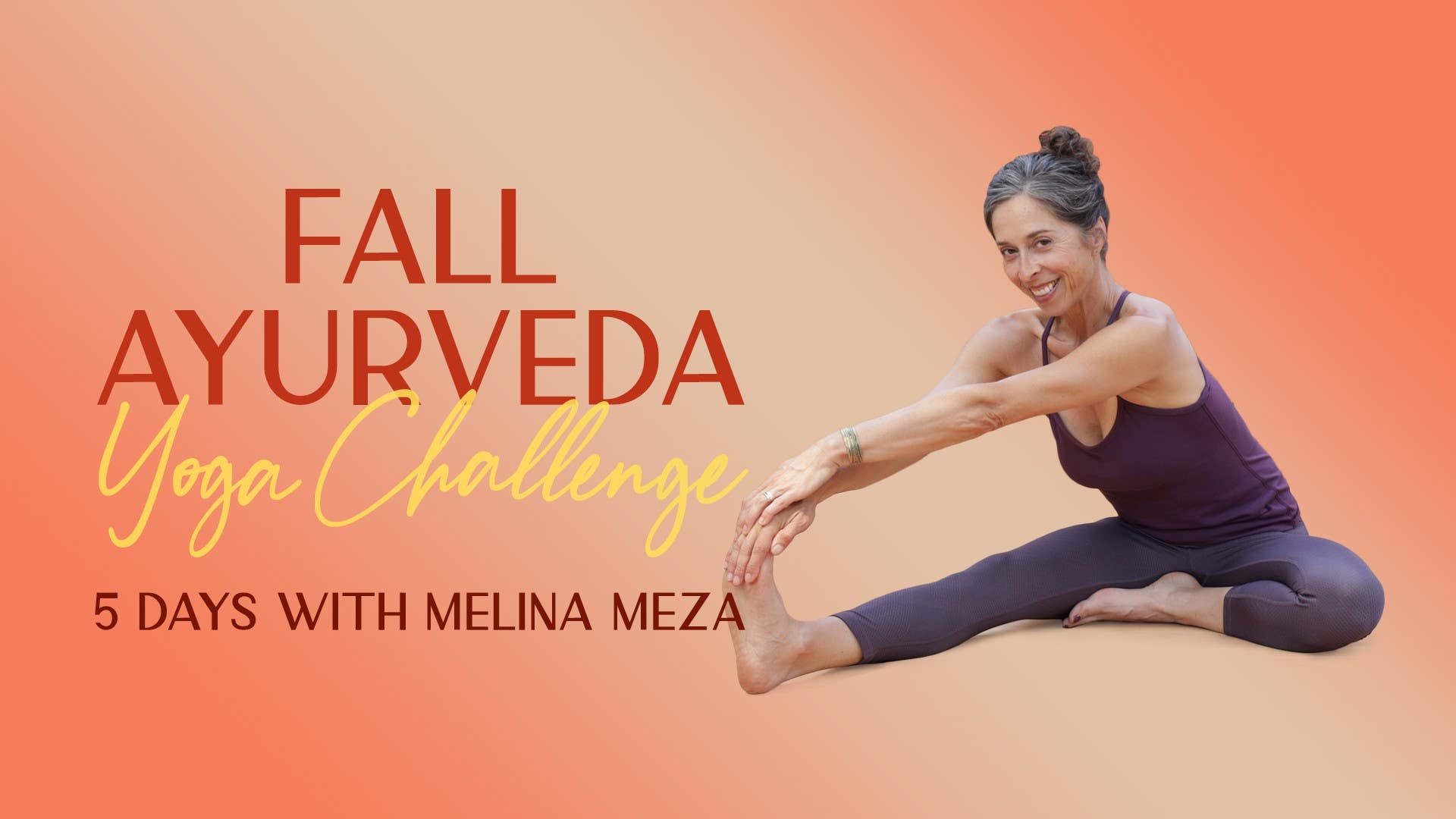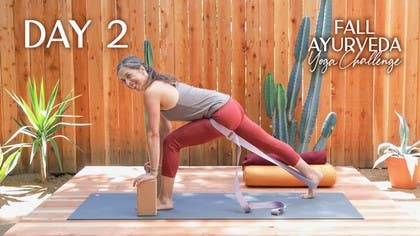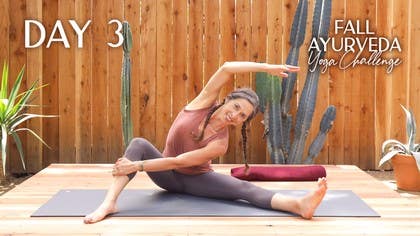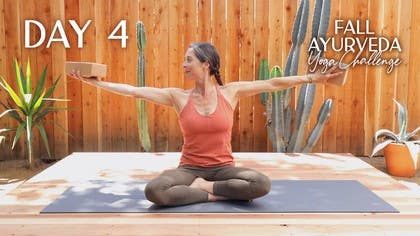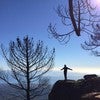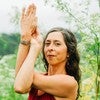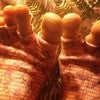Description
Tune into the breath, bones, and body to help ground in the Fall season. Melina introduces the practice of Ujjayi Pranayama, breathing with a soft, whispery sound in the back of the throat, to focus the mind's attention. We loosen and find better range of motion in joints, strengthen the back and core, and work with props to experience new opening, lift, and stability in familiar postures. Find a sweet restorative pose, and close in a seated meditation finding purpose for the energy cultivated during the practice.
Your Self Care Homework:
The homework for this challenge is cumulative, and today is focused on establishing boundaries:
- Saying "No": Melina encourages us to say "no", with love, to anything that is not a clear "yes", in order to focus our vital energy and time towards practices that are nourishing for the self.
- Bedtime Routine: Turning the lights lower and reading a relaxing book or poem before bed helps to wind down the energy and promote better sleep.
About This Video
Transcript
Read Full Transcript
Hello everyone. Welcome to day two of our fall challenge. I'm so grateful to be here with you. Thanks for choosing to be here. We're once again in this beautiful location in Ojai, California. And for today's practice that we'll do to tune in to our breath, our bones and our body, I'm going to ask that you have quite a bit of props to get us into our practice in a safe, healthy way. So if we have a bolster, a blanket, two blocks and a strap, we'll use all of those props and we're going to use most of them right at the beginning here. So if you have a blanket that you might open up for padding for your knees, then we're going to take your blocks and have them stacked and wide to give you lots of surface area. Put those way at the back of your blanket. Knees come up front and let your feet, ankles wrap around the sides of your blocks. Make sure that that's okay with your knees and ankles. And then if you will, take your bolster on top of your thighs. It acts both as some weight to help ground you here. So we come into our fall season. I'm always looking for different ways to ground myself. So that extra weight of the bolster can be helpful as well as then resting your arms on this bolster might help reduce some shoulder or neck tension. So if you've got things all in the right place, let your eyes look straight ahead to maybe where your horizon line is to just be aware of what good posture feels like. And then if you're comfortable where you are, perhaps you close your eyes without your head tilting forwards and just sense your body sinking a little bit more into this pose. And maybe we start to welcome stillness. Feeling the actual weight of your bones sinking towards the earth while at the same time maintaining some energy and awareness through the center of your spine. You know, as you sit and maybe start to take a few deeper fuller breaths as we move towards maybe slightly more quiet minds, taking these deeper, fuller breaths. If you can be aware of your belly area, starting to move towards the bolster as you breathe in. And simply aware of the belly moving away from the bolster as you breathe out. So we can find stillness in the body with the right support. A little more quiet mind as we adjust our breath to clear away the thoughts of whatever you've been doing before this class or clearing your mind of what you need to do after class. So that you tune in a little more to the wonder of this moment and that feeling in the body that's occurring as you're breathing and maybe dropping into that belly center and letting the belly center relax more to help ground you away from your head, actually into your body. Now if we're more aware of our body, our mind, let's see if we can introduce that breathing technique called Ujjayi breathing. And it's where we make the slight narrowing of the back of the throat as you're inhaling and exhaling. And then the idea is just to introduce that sound that you're hearing in the back of the throat to awaken that new sense organ. But also to give you something to pay attention to. If your mind tends to wander, as most of us will notice, our mind will tend to wander. Can we bring it back to the sound of the Ujjayi breathing? And get a little more interested in what's happening inside the body moment to moment, that whispery ocean sound in the back of your throat. And Ujjayi is actually something that requires practice. It requires some focus, some energy. So just notice how much energy does it take to stay with Ujjayi breathing for a few more cycles. Slight narrowing of the throat as you breathe in. Slight narrowing of the throat as you breathe out. Think of actually breathing from your nose so you're not straining your throat as you're taking Ujjayi breath. See if you can still listen for the sound of the breath as we start to tip your head to the left like a curious dog moving its head to the sides. Tilt your head all the way back up to center and the head tilts to the right sides. A curious dog tilt. Come back up to center and then roll again to the left before the head drops forward to the right and a little bit back. And please introduce these small little neck circles. Warming up these joints in the neck area, shoulder area. You like to take a neck movement more than once a day. So I want to introduce this so maybe you do this more than once a day especially in the fall season. The joints might be a little more creaky. Let's go ahead and bring your head right on top of your spine. If your eyes were closed, let them open. We can move the bolster towards the front end of your mat where we'll end up putting your head shortly. And if you'll transfer your hands for a moment now up to the upper corners of your chest and we'll let the elbows reach out to the side and up and forward and make a few more circles opening these ball and socket joints. And just looking for maybe better range of motion here. Can you still bring some awareness to the sound of your breath? Ujjayi. Wakening that sense organ. Now go the opposite direction. Still listening a little bit more. Now from here let your arms come straight down to your side and we'll let the left arm swing all the way up towards your ear reaching towards the ceiling and energetically through the ceiling. Left arm down, bring your right arm straight up into the air and then reach for the ceiling. Right arm down. Again, left arm up towards the ceiling. Left arm down. Bring the right arm up. Reach for the sky. Right arm down. One more time.
Left arm up. Left arm down. Inhaling as the right arm comes up. And the right arm down. Go ahead and let both arms come all the way up towards your ears. Reach through the ceiling energetically with your fingertips and lace your fingers together. We're going to turn the palms towards the sky as much as you can. Squeeze your arms in towards your ears and notice that your ribs haven't pushed forward so that you're trying to keep your ribs right over your pelvis. And then lengthening through those wonderful curves of your spine getting longer, taller as you squeeze your arms in towards your head. Feel the difference when you turn your palms towards your head and stretch your arms up. Keep your fingers laced, fingers squeezed in towards each other. One more second, getting longer, taller through your side body. Let's unleash your fingers, arms down to your sides. If you're sitting on the blocks, let's go ahead and lift off the blocks. So we're going to transfer them towards the front of your yoga mats. So if you have your blanket about the middle, about your bolster in front of your blanket and then flat blocks for your hands. So maybe your knees are about hip distance apart, hands on the blocks. The first place we drop into might not be the perfect spot. So you want to find what works for you to bring your forehead to the bolster, not your nose, but your forehead. And your hands are on blocks. Whatever height helps you, again, keep a nice straight wrist. It's like you're doing a little downward dog prep in this child's pose for your upper body. So may we rest the forehead here on your bolster and separate the knees wider if that's helpful for your body to get settled in this pose and kind of wiggle around so you're aware that eventually the body feels quiet, like deep down in your bones, you feel quiet, supported. What does it take to welcome again, stillness here in this shape, as we bring more awareness to what's opening as you're breathing in, what's settling and sinking as you exhale. And just being open again to the wonder of this moment and gathering more and more presence. Perhaps now just accentuating a little bit of that ujjayi breath, maybe three or four more breaths, refocusing your attention on the sound of your breath. Right, let's come forward now. As you come forward, you can take your bolster out of the way and set that to the side. We'll get back to that much later in class. Now, if we have the blocks to the side, we'll also get to those shortly. But for now, we just need our hands on the floor, something solid. Send your knees back a little bit so knees are more or less under your hips. It never hurts to make a few little circles, I think, with your hips, get that tailbone sacrum area loosened up, then up through your ribs, shoulder blades. How can we free up some tension or stiffness here? And let's come to neutral. Now, when you're neutral, if we take that left leg straight back and toes tap the floor, and then take your right arm up by your ear. And you might choose to stay here with your back foot on the floor or come into what we call that hunting dog pose with your left leg lifted and really energized. And take right hand down, left knee down, and take that right leg back, touch the toes to the floor. Left arm floats up by your ear and reach into that diagonal. Okay, alternative, float that back leg up. Back leg is strong, dynamic reach. And bring them both back down to the floor. Okay, first side again. Left leg, right arm, stretch, and release. Back to neutral. Right leg, left arm, reach to your diagonal. Back to neutral. One more time, left leg, right arm, reach. Back to center. And are you aware of Ujjayi breath as you're moving your body? Left leg, right arm. Back to center. Now come to that child's pose like shape now without the bolster in the blocks. And just feel what's different. You might need to move your hips more forward or maybe they go more back as you lower your head towards the floor. Send some energy out into your hands, your fingers, so you're consciously walking your fingers more and more towards the front of your mat. One more big breath here. Now let's come towards tabletop. Take your left leg back as we did moments ago and now press into the ground with your hands and spring that right leg back so you're in plank. And I want to invite you to lift your pelvis higher than you normally do and go lower than you normally do. And play around with going up and down until you feel that middle line, the center of your spine, like you do in Tadasana, where there's a sense of grace and ease through that center line of your spine. And feel the firming of your thighs, how much effort it takes to press into the floor. Keep yourself in that center line, not too high, not too low. Are you breathing?
Are you aware of Ujjayi breath? And let's lower your knees, belly, chest to the floor. Keep your toes curled under and we're going to keep the hands beside your chest. So as you inhale, let's go ahead and look forward like you do in that little cobra shape. And then as you exhale, press back into a rounded tabletop position with your toes curled under. We're going to come back towards tabletop. Drop your chest and belly to the floor. Inhale, look forward, little baby cobra, long neck. So please look down the tip of your nose. Press back into that extended child's pose. Toes stay curled under. Last time, come forward. Drop your chest to the ground, sliding through that little baby cobra on. Inhale. And then as you exhale, pressing your way back into that extended child's pose. Next time that we come forward, we're going to stay down in this prone position on your belly. Relax your toes for a moment and put your hands right underneath your face. With your forehead down on your stacked hands, elbows out to the edges of your mat. As you inhale, please start to lift your face away from your hands and lift your head up slightly towards the ceiling. So you've got a nice wide chest as you curl up. Bring your forehead down. Inhale again, lift your forehead up. Maybe some of the chest comes up and we lower down. Try a couple more times and as you're lifting, keep the neck in your awareness as part of the spine. You're lengthening. Come down. One more time, lifting up slowly through the head. And then come on down. Please place your fingertips to the sides of your mat and put your fingertips on the ground so there's some space underneath your hands like you've got a little teacup there. From here as you inhale, lift your chest and your face away from the floor. We're going to turn the head so your right ear ends up on the ground as you lower back down. Inhale, lift up. Look straight down the center line of your yoga mat and now turn your head so the left ear comes down when you lower. Inhale, lift up.
Look straight down the tip of your nose and then we'll turn so your right ear ends up on the floor. Inhale, curl up. Look straight down and turn so your left ear ends up on the ground. When you lift and look down the center line, take your hands all the way back towards your hips and plant your palms down as you lower your forehead right down to the floor. If you're wearing glasses, you're just floating your head above the floor. Please keep your hands pinned down to the floor as you lift your left leg up while you lift your face and your chest. A little back strengthening. Lower left leg and forehand. Inhale, right leg curls up as you lift your chest. Lower right leg and forehand. Left leg kicks up as you lift your face away from the floor. Lower down. Let's see if you can be aware of ujjayi breathing as you're lifting your right leg and your face. Whispery sound in the back of the throat as you lower. Whispery sound as you lift left leg and chest. Lower down. Let's do one more. Right leg comes up. Lift. Go ahead and ease your way down. Let your hands make that pillow one more time and wiggle your hips a little bit side to side. Let's let go of any tension we might have gathered there in that region. Hands beside your chest. Let's go ahead and press back up and we'll put the knees now on the blankets. If you will, we've got our blocks we're going to use now maybe in that tall position. Set my blocks down, lift the spine up and let's take your left foot forward. We'll set up which will be like that lunge position with your hands on these tall blocks. If you do a little test to make sure your right thigh can drop forward and your left leg is more or less a 90 degree angle. Tall blocks look straight ahead and lift up through the crown of your head. Part one. The second part, walk the blocks back towards your blanket so you have more space to stretch your left leg straight. We're going to flex this left ankle. See if there's sufficient stretch here and if not we bow a little bit forward. Walk the blocks back out, bend your left knee, lift up the chest, walk the blocks back towards the blanket and we're tending to that left hamstring. Maybe you bend forward if you need more stretch. Walk the blocks forward, lift the chest on inhale. One more time, say hello to the hamstrings this way. As you flex that left ankle, find that right amount of bow forward. As you come back to that lunge, we're going to curl your back right toes under, lift your right knee so now you're in a high lunge. See if you can lower your chest down a little bit more towards your left leg and now stretch that right arm forward and reach your right arm right up by your ear where you can turn your right palm to face the floor. The hope here is that you're pushing more into your feet and you're very light on your left hands. It's just there for balance. If you want to, you might even challenge yourself if the back feels okay, reach both arms forward like you're doing a warrior three in the lunge. Hands come to the blocks, put your hands on the blocks and move your hips back. You might step that back foot in. Can you pull your hips back and flex your right ankle, left ankle here? The left ankle is flexed and then come back to that lunge. Move your blocks forward, come into the high lunge, looking out over the tip of your nose. Walk the blocks back, move your hips back and can we straighten that right leg here? Maybe your back heel drops towards the floor. Sorry, that's your left leg in front. Bend your front knee. One more time. Come to that high lunge. Look straight ahead. Walk your blocks back so you can straighten your front leg a little bit. Flex that ankle. Then when we put the blocks back down, let's lower your right knee to your blanket. Hands off the blocks. Take your spine back and then take your left knee to the floor. You might tap your feet against the ground a little bit. Let go of any tension. Then take your right foot forward. Our second side, we've got the low lunge to start with. The first place again we put our body isn't always the best spot for good alignment and easy breath. Notice where you can sink into the pose and you experience that easy breath. You can start hearing ujjayi breathing again as you come to your low lunge. The second part is checking in with that right hamstring as you walk your blocks back. We flex that right ankle and maybe straight arms long back. Maybe the elbows bend and you bow forward. Walk your blocks forward. Lift your chest. Look straight ahead. Keep your neck as part of your spine. You're lengthening. Walk back if you're ready. Straighten your right leg. Flex that ankle. Blocks forward. Chest comes up on inhale. Let's do one more time in this way. Two, greet that right hamstring and maybe we bow forward if we want to check in further to that leg. We come into that high lunge. Now with the back toes curled under lift your back knee up and kind of feel again that the pelvis lifted too high or too low and you want to be in that spot where there's barely any weight on your hands. They're just there for support. If it's okay with your back, let that right left arm stretch forward towards your ear. The palm could also face the ground if that's better in your shoulder.
You can lower your chest even more to that front leg and right arm might reach forward like you're doing warrior three here in this lunge position. Maybe that's a little foreshadowing. Take one more moment reaching long through your body. Grab ahold those blocks and now walk your blocks back towards your blanket so you can move your hips back and peel that right foot off the floor. It looks like that. Heel down. Put your right foot back down. Walk your blocks forward into the lunge where you might look a little bit straight ahead. Blocks walk back towards your blanket. Flex your right ankle. Shift your hips back. You might even drop your left heel towards the floor. Walk it forward one more time. Look straight ahead into that version of the lunge. Then from that lunge, let's step that back foot forward so you've got your forward band with the feet apart and you adjust the height of the blocks to accommodate your forward fold. It could be high, medium, low or you make up a pose. None of the above always an option to make up your own shape. Let's see if you can feel your feet land. To have enough bend of the knee so your pelvis is actually tilting forwards. Take one more moment here, hanging in that forward band, potentially stretching the back of your legs a little bit. Now let's slowly come up to stand. Best way for you. We can go ahead and get rid of that blanket. I'm just going to put that on top of the bolster. Get it out of the way. Now you will find your strap. If we use the strap, we're going to use those blocks again at the top of the mat, so I'm going to keep them there. Let's say we've got the strap in half and then I'm going to fold the strap one more time. What we can do when we're here is to have this strap folded in that way. I'm going to transfer it behind my back so that my hands are maybe as wide as my shoulders.
From here, look straight ahead in your tadasana. Feet hip to stance apart. Try to look straight ahead without moving your ribcage. Move your arms further away from your back and start to bend your ankles and knees like you would in an easy chair. Keep the tension in the strap, please, as you tip forward towards your forward band. Keep the tension in the strap as you fold forward with slightly bent knees so you can get a little more stretch into your shoulder. Then hold that strap tight. Come back up to your chair pose. Take a moment, stretching the arms back. Hold that bend position in your legs. Now straight legs. Now relax the strap back towards your buttocks. One more time, maybe bring your hands a little closer together. Move them further away from your buttocks. Bend your legs like you would for chair pose. Tip forward over those bent legs and take your arms up into the air, overhead, and in the strap. Then come up through that chair pose. Look straight ahead. From those bent legs, we come up into straight legs. Move the strap away from your back. Now we're going to transfer that strap to the front of the thighs. Again, we're holding the strap about shoulder distance apart. Now if you look straight ahead, swing the strap up into the air above your head and pull tight. We're going to raise the heels up. Keep reaching the strap towards the ceiling and keep pulling tight so your shoulders are wide across your upper back. Keep reaching up while you lower your heels to the ground and sit down in your chair pose with that strap nice and tight above your head and shoulders. Come back up to straight legs. Lower your arms down in front of you. Strap tension still tight. One more time going up into the air with your strap. Raise both heels. Get more lift in your waist, shoulders, hands. Strap tension is there as you slowly drop your heels. Come into your chair pose legs. Try to pull that strap tight. Maybe even turn your head a little side to side so you're aware you're not tensing up your neck. Let's come all the way up into straight legs and lower your arms all the way down at your sides. Okay, now we're going to do an adjustment with your strap. Here's the big challenge of the day is to make a big non-sliding loop. Maybe you know your strap well enough now to make a non-sliding loop and we're going to revisit maybe some familiar poses and hopefully with this strap you're going to feel some new places. We're going to start with Warrior I. I've got a big loop. What I'm going to do is put my left foot on this strap. I'm going to take a step back with my left leg, hold this buckle part close to my waist or my navel and take a step forward with my right foot. Think of your Warrior I leg position. Now to get the strap over the front of your right thigh, we actually have to step your right leg back. Put your right leg into the loop and then take that right foot forward again to that Warrior I stance. I had to step back and I came forward. Now I've got the buckle and I can tighten the buckle down on top of my right thigh. It's still underneath more or less my back left heel. Okay, so I'm going to tighten it up on top of my right thigh and it's really worth all the effort, trust me. As you start to bend your right knee, make it as firm against the top of the thigh as you like. When you bend your right knee forward, you should feel the grounding, the immense grounding of your right femur that brings a really big smile to your face because it feels so good. And then as you're grounding into your legs, let your arms float now up towards the sky. And as the grounding of that right thigh is happening, you can keep inching your right foot forward or tightening the strap. If you aren't getting that big smile on your face, it's probably not tight enough. Okay, so going deep into that warrior one lunge as you lift up through the belly, through the chest, through your fingertips. And you wonder why doesn't every warrior one feel like this? So enjoying that for a moment. Now we can transition this arms out to the side, lift up your back heel and you're in that lunge variation. Push through your back heel to bring even more joy to this experience and we're going to lift the pelvis up away from your right thigh. Arms might lift a little higher up and how wonderful does that lunge feel here? And then we're going to reach forward, turn the blocks to that taller position and sometimes that strap needs to be adjusted to a slightly different spot. You still have control over how tight or how loose it is. Hold your blocks, hold on, the excitement continues as we walk the blocks forward. Lift your back leg and now you're in your warrior three shape. Press strongly through your back leg and this firms that right thigh back towards the hamstrings. Okay, those tall blocks, a nice long spine, kind of like we had in our earlier lunge. Take another moment there and you might even be interested in taking that right arm out to your right parallel to the floor. Turn to look towards those fingertips and you kind of feel the beginning of that half moon, revolved half moon. Both hands back on the blocks, bend your front leg and step back to your warrior one, short footprint, circle your arms up and come back to a place where you're really stable. Grounded through your legs and lifting and lengthening through your spine. Arms down at your sides and step that back foot in so you can release the strap. Okay, now side two. Take a step forward with your left foot and take a step back with your right foot. Now we're going to put this strap loop around your back right foot. It's in the loop and you put your right heel down. Okay, just see that you're in the loop with that right leg. I know this is really hard to get into this pose. Your left leg is bent so you're going to feel your warrior one base. Now take a step back with your left foot and put this left leg into the loop. Step forward with your left leg and adjust the strap. It could be different here. So you've got ability to tighten it or loosen it. So you are in charge. See that the strap is close to the back heel. You've had experience on the first side now so you might have a better sense of how to easily drop in. Pull down tightly if you like that. Bend your front knee and now you should feel really supported here. Like you could hang out here all afternoon. Take your arms up by your ears and start to feel again maybe that floating feeling in those back ribs as they lift away from your pelvis. If you're not having that experience I want to encourage you to tighten the strap more so from you grounding you naturally lift and rise up. And it really is worth adjusting that strap so it really is doing its job of grounding that front thigh. Another moment feeling the front belly lift, chest lift, the fingertips floating up towards the ceiling or sky. Now with your arms out to the side to help you balance lift up the back heel. Hips are squared and press into your back right heel to put more grounding, more pressure on the top of that left hip crease. Hopefully that also feels like it just lifts your spine up, lifts the belly up. We're going to tip forward, catch the tall blocks, put them under your shoulder line and then you've got that lunge position. Maybe you need to readjust your strap over the left leg to feel the benefit here. Bring your chest down closer to that front leg and then we start to walk your blocks forward, bend your front leg and now we're going to keep the tension in the strap and press strongly through your right leg. Now you're in that warrior three position. Again the first time you do it might not be just right so be willing to adjust your strap tension. When that right leg is working like you're pushing into a wall the extra benefit is that left thigh is pulling back towards that hamstring hopefully helping you feel like you're using your whole left foot and then get longer in your spine. If you want more adventure left arm out to the left, look to the sides. Remember that ujjayi breath. Can you track your ujjayi breath here? If not go back hands to the blocks. One more moment playing with that variation of the pose. Hands down, leave those blocks there. Big step back with that right leg. Come back to your warrior one so we end on a stable note. Feet on the ground, fingertips towards the sky. Delightful moment here. Let your arms come down to your side. Take a step forward, hold your strap and take your feet out, walk back. Now turn please and face the long edge of your mat and we might even make this strap now a little bit wider. So we're going to use that down underneath your feet and I'd like you to slide your feet out as wide as you are comfortable. You can feel the strap holding those outer edges of your feet.
So what we'll do here is keep your feet as wide as you're comfortable and you can let go of that tail end of the strap. Stand tall and roll your feet out towards those edges so you're really aware of what's supporting you without locking your knees. Keep pressing out to the outer edges of your feet as you tip forward and put your fingertips on the floor and then I'd like you to turn your fingertips to face the opposite direction of your toes as you put your wrist down on the floor. So wrists are facing that long front edge of your mat. You might even tuck your hands under the lower strap for some grounding, fingers are pointing away from the toes, opposite direction of your toes. Bring your chin towards your throat, have a nice long spine and keep walking your fingers back. Shoulders are moving away from your ears. Let your head hang here as you push out into those edges of your feet. Can you feel some waking up of those inner legs as you press out through the legs here? Put your hands in front of you right under your shoulder line, bend your knees, put your hands on your thighs and use your legs to transfer all the way back up to standing. Now from here, bring your feet a little closer together so you can grab your blocks. Once you have your blocks, bring your feet in a little bit closer together. You can leave the strap there. Turn your heels in, put your blocks on top of your thighs. We did this in a much earlier show of mine, but we haven't done it recently. So if you put your blocks on top of your thighs, bend your knees and to keep them in place, we've got to lean forward as you squat. Basically, ribs pin those blocks in place. The first time again isn't always going to be the best match, so give it some time to practice holding those ribs in place, the blocks in place. Put your palms down, now turn your toes straight ahead. As we lower the head towards the ground, the weight of your torso should help pin those blocks more to your thighs, should help your thighs press back towards your hamstrings, similar to what was happening in your warrior one pose. Maybe your hands walk back further so your fingertips could now line up with your toe line potentially. Point your head all the way to the floor and if you want stronger sensation in the legs, bring your feet closer together. In which case I like to hold opposite elbow and keep letting my torso press into those bricks, the blocks that press into the thighs that help me wake up my legs more than they're used to in the forward bend. So my legs are doing lots of work as my spine relaxes. How's that for some good alignment? Now as we bend the knees, let's catch those blocks with your hands and then hold them as you come all the way up to stand. Take the blocks, step back safely out of the straps, set the blocks off to the side, we won't need them, but we do want the strap and we do want the strap in that big loop that you made. So let's go ahead and have a seat and as you sit down we won't need anything else, I don't believe. For now as we put our whole body into this loop, we're going to put the strap down towards the sacrum. Take a moment to walk your legs out, untwist things that got twisted and as we set this in place around the sacrum area, have access to this adjustable strap part and tighten it up so that it feels supportive. And what I mean by that is it moves your pelvis from that slouchy shape into the neutral kind of yogi posture. So that that lower back is long and you pull as tightly as you need to and hopefully this again is like a big aha in your body for like, oh this is what it feels like to have good posture. The pelvis to be rolling forward with straight legs. So your arms might be grounded at your side for a moment, press into the floor, lift your spine up. I just want you to have that experience of that shape here. Now if we can keep that a little bit in our awareness how the chest even lifts here, as we bend the knees and we're going to hold onto the strap, as you lean a little bit back, hold the strap and lift your feet up about as high as your knees.
Your boat pose. Look out towards the toes, pull yourself in a little closer to your legs and then there's a little slack now that you can take that strap up to the back of your shoulder blade line. Now for the real adventure going to hold that strap and go all the way up. Here I usually like to tighten this just a little more so I can push into my legs. You want to start the adventure with your arms back here. Use them as a prop to lean into to get used to lifting your chest. Look maybe out beyond your toes and if you want that adventure reaching forward you've got your boat pose and who know boat pose could feel this awesome. So if you're trying to find that wonderful balance the strap is doing so much work for you. Now we'll bend the knees, hold onto the strap and put your legs down. Now if we roll down onto your back, make a little adjustment, roll down onto your back, keep that big loop, the strap is up around your shoulder blades. We just transfer now onto your back. Let's go ahead and put your right foot into that strap. Keep your left leg bent for a moment and slide that strap up around your shoulder blades. Tighten it up as much as you need to to have that right leg up in the air without using your arms. Arms get to drop out to your sides. Let's take a moment now and see if it feels okay in your back to put your left leg all the way down on the floor. Press up through that right leg, shoulders relaxed back towards the floor and so it's like a hands free version of our strap to foot pose. One more moment stretching up through that right leg and then maybe we open that right leg at just an inch or three out to the right, not very far. Just notice what that feels like. Come back to center line, put your hands up on the strap, stretch for the strap and lift your head up towards your right leg, curl up and bring the head back down. Swing your left leg up into the strap now and put your right foot down, right leg stays bent. Adjust the strap so you feel a good stretch in your left leg. Arms up to your sides. Stretch your right leg maybe to the floor and see if that feels okay in your lower back. If it doesn't, please go back to a bent right leg. Opening that left leg an inch or two or three, not very far out to the left. Just see what that feels like. Maybe we come back into contact with that Ujjayi breath now that you're on the ground. Left leg drifting back to center. Hands reach up for the straps and bend your elbows as you lift your head up towards that left leg. Come on back down to the floor.
Bring both knees in towards your chest and now we're going to let both feet come up into the strap and we're going to take your arms and let them come out from the sides. You're going to release your arms from the loop and you're going to put the loop more around the back of your neck for a second. As soon as the strap is around the back of your neck, we're going to actually slide it now up to the back of your ears and tuck the strap into the back of your ears. Kind of maybe like where a headband would rest. So you're basically holding the occipital ridge with the strap if you're aware of that bony landmark. So I tuck it behind my ears however weird that is. I want to have access to the adjustable parts because I might need to give myself more slack. More slack to stretch my legs forward and it doesn't always work the first position you're in. So give yourself time to adjust. Press your feet legs forward to help lift your head a couple of inches to find the right amount of tension, stretch, traction in the back of the neck that allows you to let your arms drop out to the sides. So there is a certain management of how much your legs are going forward, how much your head is falling back into the strap. And remember the strap is no longer in the back of your neck, it's up to the base of your skull. So then there becomes this matter again of finding the right alignment where your body is quiet again. Where the bones feel still, heavy. And as your eyes close maybe the eyes have a slight downward cast towards the lungs. This might be one of our alternatives, legs up the wall. If this is not good for your neck at all, you have the option to do legs up the wall. That would be a great alternative if lifting your head this way doesn't feel safe. This pose like some of the restorative poses is often better with time. So give yourself the opportunity again just to feel again what's happening in the legs, the sensations while they're up in this inversion. Is there any different feeling tone in the belly that we might recognize? Any different sensation around the heart? And any different observation of the mind or coming back into that awareness of ujjayi to help keep the mind focused, calm, spacious. State doesn't necessarily always arrive immediately or quickly. So just having hope that maybe we might have a little more clarity in the mind or calm or quiet with a few more moments and now this hopefully comfortable shape. Let's go ahead and keep that breath awareness please. Ujjayi breath, whispery sound, the back of the throat. As you bend your knees and ever so carefully reach up for your strap. Bend your knees and we'll get rid of that strap out from underneath your head. Let your head rest on the ground here. We'll take the strap and have the strap out of your way for right now as you put your feet down on the floor and just feel neutral for a moment. Maybe turn your head once you've settled a little bit to the right, back to center. Head turns a little bit to the left and then back to center. Okay, so now in place of shavasana, I wanted to see if you're comfortable with a bolster underneath your back and a blanket underneath your head or stay close to the ground if that feels like a better option for you. So I've got the bolster, I've got the blankets and as I come down to the bolster I want to slide myself back so it catches the back of my rib cage. Blanket catches that spot where the strap was under the occipital ridge. And now with your arms down at your sides, maybe your legs are bent. If you like hip opening, you could head towards that direction or maybe we like legs straight. Place your arms in place where they're comfortable and maybe we have this openness through the chest so we can pay a little more attention to what happens as we turn our awareness more to our breath. And opening into the rib cage, the lungs, whether you've got a bolster underneath you or the earth underneath you. Bring awareness back to your breath and then awareness to the sound of the breath that we've been calling Ujjayi breathing. It's an actual practice and requires a certain amount of effort to keep coming back to paying attention to the sound in your breath. As we use this as our Shavasana relaxation, can you ask more of your body to relax now? Perhaps even tune into more subtle movements as you breathe. Maybe you can be more aware of the vibration of the bones in the body from our practice today. What's shifted? What's changed? Let's put another minute of effort into the practice of breath awareness. The sound of Ujjayi breathing, the muscles and bones of your body completely relaxed.
All right. And as you are here, making some little movements in fingers and toes to prepare yourself for the next shape, which will be on whatever side you want to turn towards to come to that side pose, fetal pose, before we come up to sit. So please take your time. Maybe your eyes stay closed through the transitions. Grab what's helpful for you to sit. I'm going to sit right on top of the bolster and open my blanket up, make a rolled shape with that long rolled shape right in front of my bolster across my ankles. So I've got a little lift under my ankles and then hold on to the knees. When your props feel like they're in the right place, we're going to spend just a couple of minutes centering here again, focusing on alignment first. And what's it like now in our vertical position, our meditation seat to tune back into breath awareness, which is different than changing the breath. Breath awareness might lead to more presence, might be a wonderful way to gather more of our prana, conscious energy that we then choose again to move forward in our day with more focus. So we know where we're putting our prana as we gather our prana. What way might your energy that you've cultivated here be of purpose in this new day? And then using the Ujjayi breath technique for one more minute now with sound. Ujjayi breath is a sound practice that we're listening for to keep us more alert or interested perhaps. And this breath awareness practice and keep coming back to that soft whispery or windy sound in the back of the breath. And may that awareness stay turned inwards, be aware of that breath as a useful tool to navigate through the day, come back to your center. We lift the hands together potentially in front of the heart center. And may our practice again not only benefit us but all beings everywhere. Namaste. Alright, so thanks for being part of day two here for the asana portion of the class, for a little bit of pranayama awareness today. And as a practice to grow some of the Ayurveda into your life, a practice I like to introduce in the fall. I know it's a big step from yesterday's but is what I call boundaries. So from today on maybe for the next week or maybe for the next month is to introduce the idea of saying no. And to say no with love, to be aware that no is a complete sentence. And the idea is that we say no to everything that doesn't feel like a yes. And in my experience of doing the boundary practice with no is that I often end up having a lot more time for myself. So as we are moving into the fall and shorter days, it might be helpful to be home more or with yourself more to do nourishing things. So for example, I know when I say no to invitations to go out, I find that I might be home and I can make myself a meal or I can prepare food for the next day. Things that I wouldn't have done if I stayed out late or that there's more time to do an oil massage. It's more time to take a bath, more time to be creative. So it's a little bit more energy that's towards yourself and things that are actually nourishing for you versus things when you're out too much in the autumn, moves your prana, your vital energy this way, which is sort of opposite of what's happening in the fall. It's the beginning of turning your energy inward towards that more dormant season. So the boundary practice again, you might learn a lot from doing it for one day. In my experience doing it for a week, you'll learn even more and then doing it for over the course of 30 days, you'll learn hopefully a whole bunch of what brings you joy and what you might do sometimes out of obligation that we might start practicing a new way to say no and to have that boundary to say no with love and to remember no is a complete sentence and to really empower yourself to take more charge of your time. It's so precious. And the other thing then when we say no in the fall, I like to introduce is the idea before bed is for maybe a half hour if you don't already do this to read in bed and not read necessarily that mystery novel or something that's going to be really stimulating, but to read a book in bed as a way to relax from electronic stimulation as a way to cozy up in bed and have that kind of sequence where you're relaxing before you sleep. And a lot of times people will find that if they do something relaxing before bed before they try to sleep, that they actually sleep better. So if you snuggle up and you've got all the right lights that you need, not too bright because ideally you're decreasing the light in your room, which can also be stimulating, but just to read. And so it's a slow paced activity versus electronic speed, which is more fast pace. And the bright light again of the electronic devices tends to not necessarily promote better sleep. Okay. So if we think of protecting our sleep as one of our winter fall, moving toward winter practices, see if reading is a way to get you to kind of wind down your energy and start introducing more healthy evening routines into your practice.
So finding a good stack of books, maybe it's the time for the yoga, inspirational books, or even better yet, maybe poetry books. So there are concise verses, um, that lets you kind of go to sleep with something really positive in your mind. And again, continue to do the things that keep you hydrated in the morning. Um, the oil treatments, whether you do them in the morning to protect yourself from the dry climates. Um, and to just give yourself that extra coating barrier, which is in itself its own boundary when you put the oil on your skin. So I hope some of these are helpful and useful tools to, um, expand your yoga practice so that you have more consciousness in the things that you're doing off your yoga mats. And then you know that you're doing yoga more throughout your whole entire day. All right. It's a pleasure working with you and I hope these again work for you and your community, maybe even your family. It's fun to do these together with others. Have a wonderful rest of the day and I look forward to hopefully seeing you tomorrow here on yoga anytime. Namaste everybody. Thank you.
Fall Ayurveda Yoga Challenge
Comments
You need to be a subscriber to post a comment.
Please Log In or Create an Account to start your free trial.
